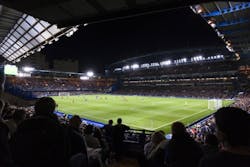Philips lights Chelsea soccer venue with LED floodlights
The Stamford Bridge stadium becomes the first top-level soccer stadium to feature LED lighting for better viewer experience including those watching on TV.
Philips Lighting has announced that the Stamford Bridge stadium located in London, home of the Chelsea Football Club (FC) of the English Premier League, has been upgraded to Philips ArenaVision LED floodlighting. The installation is a first in the solid-state lighting (SSL) sector for a top-level soccer venue and the club owners believe the new lighting will improve the experience for players and fans -- including fans watching on TV.
The new lighting was first put to the test on August 12 when Chelsea played a friendly match against Real Sociedad just before the opening of the Premier League regular season. As the nearby photo illustrates, the lighting provides even, uniform illumination of the playing field and what Philips describes as "exceptional vertical illuminance on the players." Moreover, the club expects the lighting to be maintenance free for upwards of ten years whereas the previous metal halide (MH) lighting required lamp replacement on a three-year cycle.
Top-level professional sports venues are one of the final applications being addressed by LED lighting, Until recently, LED fixtures that could deliver the required light levels were too expensive and heavy for widespread deployment. But the situation is changing with LED flux gains and sports venues are moving to the technology. We recently covered the plans for the Ottawa Senators NHL hockey team in Canada to play under LED lighting this season. Large college venues are also adopting SSL going back to the lighting of the Weber State basketball arena in Utah that we covered last year.
Still, the Chelsea project is noteworthy because of the position and notoriety of the Premier League and the requirements the league places on venues. For example, the league requires lighting that optimizes the ability of TV broadcasters to deliver high-definition video including flicker-free viewing of super slow-motion replays. "Our LED pitch lighting meets the new stringent broadcast criteria of the English Premier League in helping to deliver high-definition, flicker-free super-slow motion images and ensures that Chelsea delivers the best possible viewing experience to the 40,000 plus fans in the stadium as well as those at home," said Eric Rondolat, CEO of Philips Lighting.
"I am delighted to be able to work with Philips on delivering the best possible environment for our supporters to enjoy Chelsea matches in," said Ron Gourlay, chief executive of Chelsea FC. "Once again, Chelsea Football Club is at the forefront of innovation and we look forward to many more memorable games at Stamford Bridge under this new floodlighting system."
The LED lighting delivers numerous benefits over conventional lighting. For example, the lights can be turned on and off instantly whereas MH lights have a long restrike period, meaning that mechanical shutters are required to control the lighting. The SSL installation includes a control system that allows operators to switch or dim each floodlight individually. The controls will allow the club to present dynamic entertainment lighting effects for pre- and post-match shows.

Maury Wright | Editor in Chief
Maury Wright is an electronics engineer turned technology journalist, who has focused specifically on the LED & Lighting industry for the past decade. Wright first wrote for LEDs Magazine as a contractor in 2010, and took over as Editor-in-Chief in 2012. He has broad experience in technology areas ranging from microprocessors to digital media to wireless networks that he gained over 30 years in the trade press. Wright has experience running global editorial operations, such as during his tenure as worldwide editorial director of EDN Magazine, and has been instrumental in launching publication websites going back to the earliest days of the Internet. Wright has won numerous industry awards, including multiple ASBPE national awards for B2B journalism excellence, and has received finalist recognition for LEDs Magazine in the FOLIO Eddie Awards. He received a BS in electrical engineering from Auburn University.





